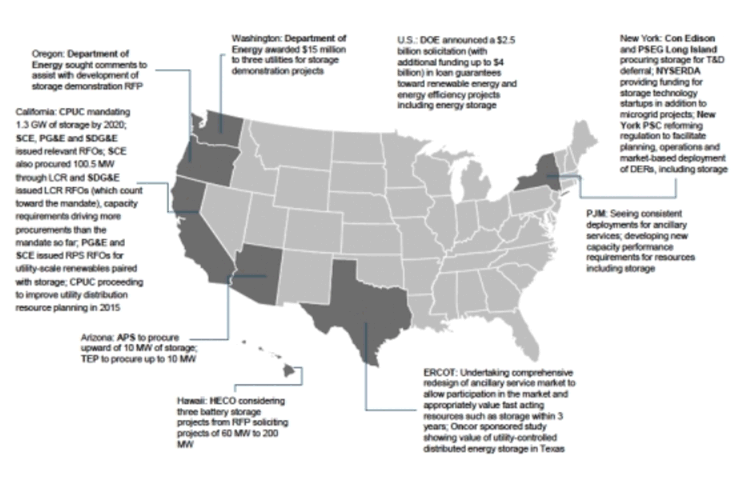3.4 DER Capabilities and DER System Architectures
3.4.4 Distribution Energy Storage Systems (DESS)
Energy Storage Systems (ESSs) are by their nature flexible resources and therefore beneficial to reliable, low-carbon grid operations. ESSs can be used to shift loads during high peak load conditions and provide the operational flexibility to quickly change electricity production and consumption and maintain needed output levels for the time required, particularly as increasing amounts of variable renewable energy resources are interconnected to the grid. ESS systems can be connected at the transmission level, such as in substations, but may often be connected to the sub-transmission or distribution levels.
In California, the California Public Utilities Commission (CPUC) identified energy storage procurement targets for each of the Investor Owned Utilities (IOUs) totaling 1,325 MW to be completed by the end of 2020 and implemented by 2024 . This decision has led to significant discussions on the different types of values of ESS energy capacity and ability to provide flexible resources (ramping) for off-setting transmission costs. Similarly discussions are being held in the Distribution Resource Planning (see 3.6.1) process on the value of energy storage to off-set both transmission costs as well as locational distribution costs. Stakeholders are particularly interested in how to identify the need for flexible capacity and the valuation methodology for that capability in the CPUC resource adequacy program, and second, to clarify tariff treatment of storage facilities, in particular between charging and discharging of electricity.
In addition to providing resource adequacy and flexibility for the transmission system, distribution-connected energy storage systems (DESS) have special capabilities that make them particularly important in the management of distribution systems with high penetrations of DER systems. Since they are controllable, include inverter functionalities, and can both generate and act as loads, they can be used to counteract many of the fluctuations and variability of not only renewable resources but also loads.
DESS systems have the potential to cancel or minimize the "intermittency" associated with renewable resources. As opposed to transmission-level energy storage, which is often deployed in a central location such as a substation, DESS systems can be deployed at various points on the distribution circuit, either as part of a combined generation-storage system or at least close to the sources of intermittency.
DESS systems may also be used to respond autonomously to frequency deviations by changing their charging or discharging rates, thus smoothing the frequency deviations. They may also be used, possibly in aggregate, for more traditional automatic generation control (AGC). These DESS devices may be utility-owned or the advanced storage functionality may be available through third party owners/operators.
Utilities that are evaluating the deployment of DESS systems for their own grid management purposes, generally need to assess some of the following issues:
- Evaluation of the distribution system to identify circuits that have a high penetration of renewables which can lead to intermittency problems
- Evaluation and testing of DESS devices for intermittency mitigation
- Development of interoperable communication requirements to ensure that the devices acquired are able to interface with utility SCADA systems
- Deployment of pilot installations to evaluate the performance of the equipment
- Development of a plan to install these devices on distribution transformers that are serving EV charging stations
One of the current discussion areas are how to treat DESS devices that are ostensibly “behind the meter”. For instance, should they be treated as just load (if they are truly “non-exporting”), or since they could impact exports of power across the PCC, should they always be treated as DER systems and go through the same assessment processes for interconnection.
Another major rate issue is what should the rate be for charging energy storage systems. There are two types of storage applications:
- Energy that is stored for later injection back to the grid to provide grid services (e.g. resource adequacy capacity, flexible capacity, frequency support)
- Energy stored and injected at different times of the day to change customer consumption patterns (e.g. load shifting, often for the benefit of the customer facility to help mitigate demand charges and minimize consumption during higher rate periods)
For the first case, grid services can be provided to the wholesale market or to the utilities for transmission support and/or distribution system management, thus consistent with other generation sources . In California, the rates for these are determined by the ISO interconnection tariff (for transmission-connected) and by the FERC jurisdictional WDAT (for distribution-connected). For the second case, the applicable tariff is determined by the Rule 21 interconnection agreement with the utility.
Issues can arise when DESS might be used for multiple purposes for both the wholesale market and the distribution grid. For instance, the DESS could provide reliability services to the distribution grid and capacity services to the wholesale market. Even though the DESS may be providing benefits to the distribution system, tariffs and rules are not in place to value these capabilities and procurement does not recognize these additional values. Another example is when DESS is combined with renewable resources to provide “hybrid configurations”. The value of this combination as well as the individual values of the component units are not clearly understood or included in rates.
Energy storage is rapidly coming into its own. According to Greentech Media , “Energy storage is a small market experiencing fierce growth. The U.S. installed 61.9 megawatts of energy storage in 2014, and GTM Research is forecasting 220 megawatts to be installed in 2015. But, as with the U.S. solar industry, energy storage projects are clustered in states with incentives or in regions where markets are able to place a value on storage.” As shown in Figure 13, some States are more proactive than others.

Figure 13 : Energy storage initiatives in different States